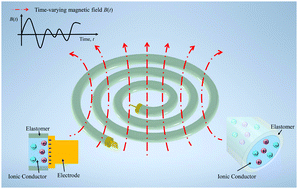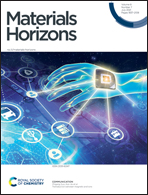Transduction between magnets and ions†
Abstract
A time-varying magnetic field generates an electric field in an electrolyte, in which ions move. This magnetoionic transduction is studied here in several arrangements. The electrolyte is a hydrogel containing mobile ions, and is in contact with two metallic electrodes. An alternating electric current applied to a metal coil generates a time-varying magnetic field. In response, ions in the hydrogel move. The two hydrogel/electrode interfaces are non-faradaic and accumulate excess ions of opposite signs, which attract and repel electrons in the two electrodes. When the two electrodes are connected to a voltmeter of internal resistance much larger than that of the hydrogel, an open-circuit voltage is measured, linear in the alternating current applied to the metal coil. A metal coil and a hydrogel coil form an ionotronic transformer, in which an alternating electric current in the metal coil induces an alternating ionic current in the hydrogel coil. Such a transformer can be used for noncontact power transmission, with a voltage high enough to turn on many light-emitting diodes in series. The hydrogel is soft, and readily conforms to a curved surface, such as a glove on a human hand. Motion of the hand can be detected by noncontact magnetoionic transduction.



 Please wait while we load your content...
Please wait while we load your content...